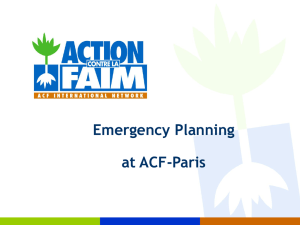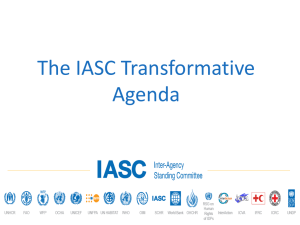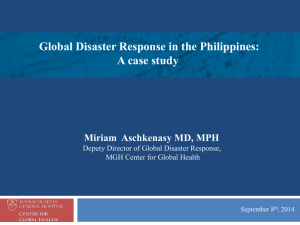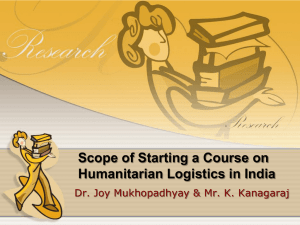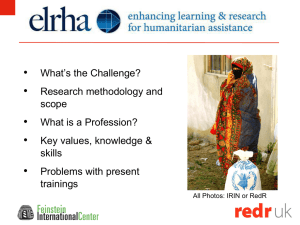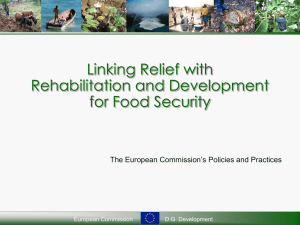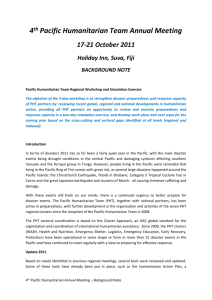4.08 UN OCHA Roles on Disaster Preparedness and Response in
advertisement
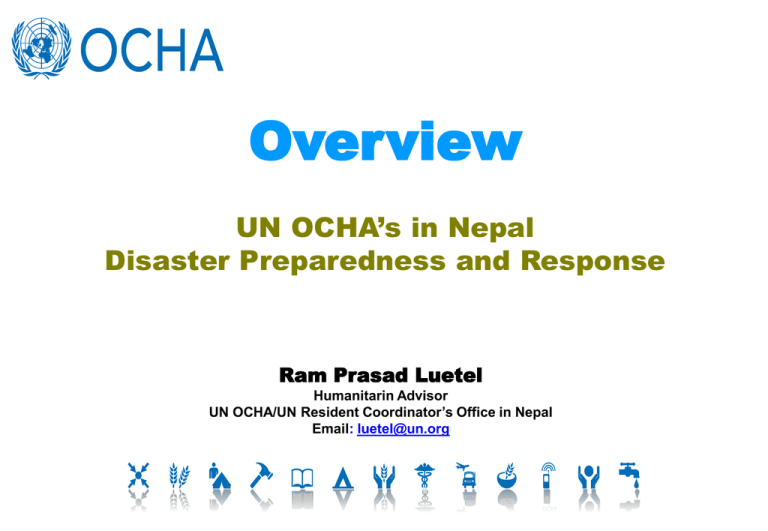
Overview UN OCHA’s in Nepal Disaster Preparedness and Response Ram Prasad Luetel Humanitarin Advisor UN OCHA/UN Resident Coordinator’s Office in Nepal Email: luetel@un.org Structure of Presentation 1. UN OCHA in Nepal and contribution in preparedness 2. Cluster System in Nepal 3. Humanitarian Actors ??? 4. Cluster Contingency Plan 2012/13 5. Response Coordination Mechanism Government Non-Government Joint Coordination mechanism 6. Relevant Websites 7. Q & A Who We Are OCHA is the part of the United Nations Secretariat responsible for bringing together humanitarian actors to ensure a coherent response to emergencies. General Assembly Resolution 46/182, Dec 1991 Credit: OCHA/Tagaza Djibo UN OCHA in Nepal • Established in 2005, • UN OCHA coordinates inter-agency humanitarian response preparedness and response, • Recently, downsized to Humanitarian Advisory Team and works within the UN RC Office, • Etc.. Joint Framework on Disaster Preparedness and Response •Levels •Government level •International Humanitarian Community •Policy level •Cabinet •Resident/Humanitarian Coordinator •Strategic level •Central Natural Disaster Relief Committee •Operation • Ministry of Home Affairs • Regional Disaster Relief al level Committee • District Disaster Relief Committee • Humanitarian Country Team •Nepal Risk Reduction Consortium • Cluster Coordination Mechanism • Association of INGOs (AINTGDM) • DPNet (Joint Forum of I/NGOs, UN, RCRC, others) Key Achievements on Humanitarian Preparedness (2005 -2014) A. Policy Advocacy National Strategy on Disaster Risk Management 2009 National Disaster Response Framework 2013 National Strategy on USAR capacity developed 2014 Nepal Risk Reduction Consortium Established Guidance Note 2011 Disaster Preparedness and Response Planning; -All districts DPRP DRR Focal Persons/Disaster Units established in Ministries/Departments/Security Offices Emergency Customs Clearance Procedures (Model Agreement) Dead Body Management Guidelines… Key Achievements on Humanitarian Preparedness (2005 -2014) B. Information Management Guidelines on Common joint needs assessment tools developed Established Emergency Operation Centres Exposures visit to Gov officials including security forces in different SIMEX/INSARAG, Civil Military courses …. Open spaces (83) Identified –implementation started Nepal Information Platform continued from RCO Office Information Products and Mapping Tools (RC Office) Key Achievements on Humanitarian Preparedness (2005 -2014) C. Coordination Support Cluster approach rolled out in 2008 & strengthened Inter-Cluster coordination, Contingency Plan prepared/updated Set of coordination mechanism during mega disasters; LEMA/NEOC, OSOCC and MNMCC (as per NDRF) OCHA facilitates OSOCC & RDC establishment INSARAG exercise held in 2009 & 2012 Civil Military Coordination training held & meeting continue Security forces engaged in different national simulations Joint coordination meetings (humanitarian/Gov) continue Coordinated response during Koshi Floods 2008 Key Achievements on Humanitarian Preparedness (2005 -2014) D. Humanitarian Financing Humanitarian financing increased (2008-2012) -CERF, ECG, CAP The inter-cluster coordination is one of the most important achievements Cluster System in Nepal Cluster Leads (Government) Cluster Co-Leads Emergency Health Min of Health & Population Water, Sanitation & Hygiene Min of Urban Development (Humanitarian Agency) WHO UNICEF Emergency Food Security Min of Agri. Development Emergency Logistics Min of Home Affairs Emergency Shelter Min of Urban Development Emergency Protection Min. of Women & Social Welfare Emergency Telecomm Min. of Information Communication Min of Urban Development Clusters (since 2008) Camp Coordination & Camp Mgmt Emergency Education Min. of Education Emergency Nutrition Min of Health & Population Early Recovery (as a network) Min of Federal Affairs/Local Dev and Min of Urban Development FAO & WFP (Rotational) WFP IFRC (Nepal Red Cross) UNHCR /UNICEF/UNFPA WFP IOM UNICEF /Save the Children UNICEF UNDP Cluster Contingency Plan 2012/13 Every Cluster has prepared cluster contingency plan and updated in 2013 based on the scenarios of major Earthquake impact in KTM Valley (> 8.2 Rector quake) Scenario: Total projected population: 2.5 -3.0 Million (2011 CBS) Total Buildings: 500K 60% Buildings Damage: 300K Buildings Homeless Population: 1.8-2.1 M Death: 100,000 Serious Injury: 100,000 Moderate Injury: 200,000 Who are the Humanitarian Actors? (cluster mechanisms) 1. Affected Country (Government and Civil Society) 2. Military / Security Forces • National Forces: Nepalese Army, Nepal Police, Armed Police Force • International Military Forces: ….. 3. UN Agencies and International Organizations 4. Red Cross/Red Crescent Movement: • IFRC and National Societies • ICRC 5. Non Governmental Organizations (NGOs) • International • National 6. Donors 7. Private Sector: FNCCI/… 8. Others including media, …… Response Coordination Mechanism Government Response Coordination Mechanism UN Resident / Humanitarian Coordinator Humanitarian Cluster Activated International Appeal Government Agencies GON Declares Disaster (area, time) CNDRC meeting held INGOs & others MoHA, / NEOC Red Cross Movements Donors & others Disaster Situation Analysis (CDO, DDRC) Non-Government Response Coordination Mechanism Humanitarian Country Team (Principal). Chair: HC Members: AIN, FAO, IFRC, IOM, OHCHR, OCHA, UNMIN, UNDP, UNFPA, UNHCR, UNICEF, WFP, WHO, Standing Invitees, ICRC 1. 2. 3. 4. 5. 6. 7. Humanitarian Country Team (Operational). Chair: OCHA 8. 9. 10. 11. Members: Cluster Leads, AIN, FAO, IFRC, IOM, NRCS, OHCHR, SC, UNDP, UNFPA, UNHABITAT, UNICEF, WFP, WHO, ICRC (Observers.) Camp Coordination & Camp Mgmt Education Shelter Health Nutrition Protection Water, Sanitation & Hygiene Food Security Telecomm Logistics Early Recovery (as a network) Government Cluster Focal Points Cluster Coordination Resident or Humanitarian Coordinator Joint Response coordination mechanism between National Authorities and International Actors during mega disaster response Central Natural Disaster Relief Committee (CNDRC) Assisting International Forces 1 Assisting International Forces 2 Assisting International Forces 3 NEOC/LEMA Multi-National Military Force Coordination Center On Site Operations Coordination Centre (OSOCC) Resident Coordinator UN Agencies, Funds and Programmes I/NGOs Red Cross Movements International Responders Ongoing Activities on Disaster Response Preparedness and Risk Reduction Measures in Nepal Disaster Preparedness and Response Initiatives • GoN endorsed the National Strategy on Disaster Risk Management 2009 and in implementation; • GoN and UN has jointly signed an Model Agreement (Customs Procedures) to expedite import, export and transit of relief consignments during the major disasters; • Risk Reduction/Flagship Program developed as an Overarching strategy where GoN and International communities (2011-2015) work together; • GoN endorsed and implemented widely the Guidance Note for preparing the Disaster Preparedness Plan 2011 at district and local levels; Cont…DPR Initiatives • District Disaster Preparedness and Response Plans developed in all districts; • National Disaster Response Framework approved; • 83 open spaces Identified to use as evacuation and other humanitarian purpose in KTM valley; • National Emergency Operation Center established; • Ten Clusters and one Early Recovery network have prepared Contingency Plan; • DRR Focal Point established in key Ministries, Prime Minister Office, National Planning Commission and Security Forces; • Dead Body Management Guidelines endorsed; Cont…DPR Initiatives • • • • 5 new warehouses in regional centers; Disaster Management Training Centre (first of its kind) established at Armed Police Force; Get Airport Ready for Disaster (GARD) Training held in 2010 ; TIA is implementing GARD Training recommendations e.g. retrofitting of the existing facilities, preparation of Airport Contingency Plan and procurement of heavy equipments; Cont…DPR Initiatives • Several simulation exercises organized with the support of various partners (mil-mil and civ & mil etc..); • Retrofitting underway; • Line Ministries established DM Unit • Security Forces established separate DM Unit; • Program for Enhancement of Emergency Response (PEER) trainings has been initiated since 1998 (MFR, CSSR, HOPE and other specialized courses like Water Rescue, Fire Rescue, Mountain Rescue, etc) in the security forces; of Schools and Hospitals Cont…DPR Initiatives Relevant Websites • Documents related to Nepal: Ministry of Home Affairs RC Office, Nepal http://www.moha.gov.np/np/ www.un.org.np\disaster preparedness • Documents related to Global level: Relief Web Financial Tracking System Humanitarian Appeals – Humanitarian Early Warning– Global Disaster Alert and Co. Sy. Humanitarian News and Analysis – Humanitarian Centers/Partners OCHA – Global level Inter-Agency Standing Committee – www.reliefweb.int www.reliefweb.int/fts www.humanitarianappeal.net www.hewsweb.org www.gdacs.org www.IRINnews.org www.humanitarianinfo.org www.ochaonline.org www.humanitarianinfor.org/iasc www.unocha.org
